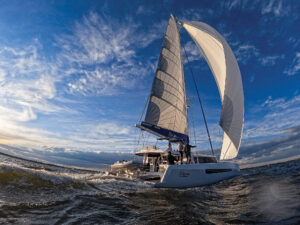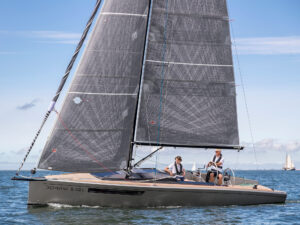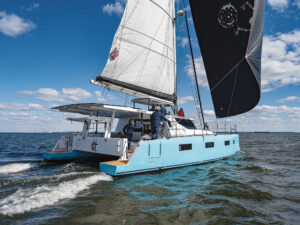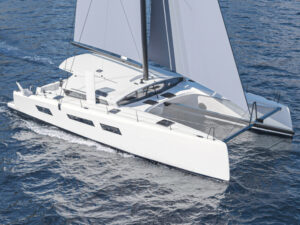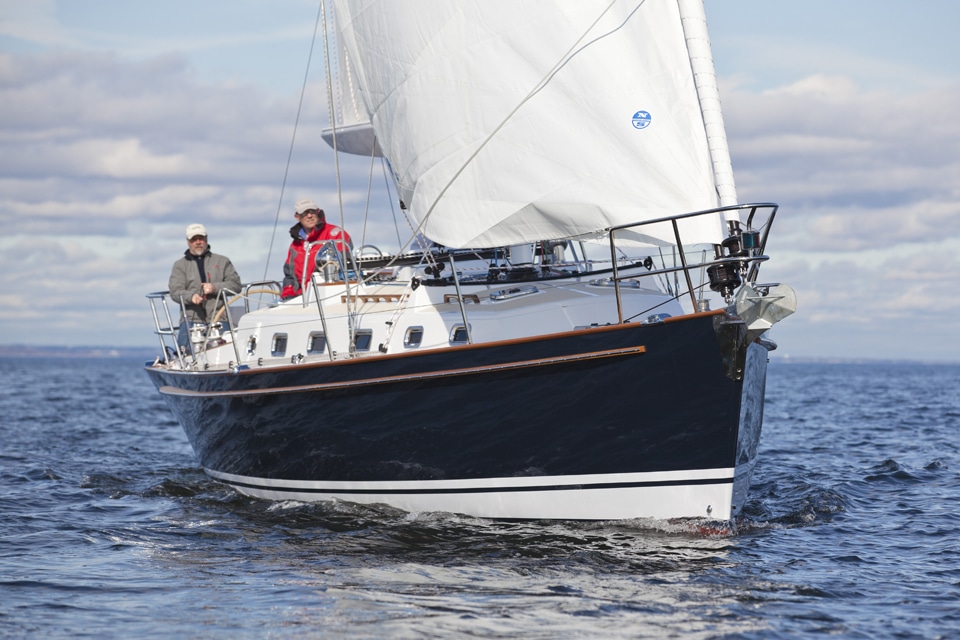
The middle of March is typically not a time that New Englanders rush to go sailing, but that’s exactly when I found myself hustling down the highway toward Mamaroneck, New York, to catch up with Tim Jackett and get a look at his latest addition to the performance-cruiser genre, the Tartan 4000. Like other recent sailboats from the Tartan Marine Company facilities in Painesville, Ohio, the 4000 hits both corner posts of its design brief square on: Elegantly rendered creature comforts are encapsulated by a slippery hull and a power-packed sail plan that promises—and delivers—a seakindly and spirited ride.
I managed to arrive for our sail a few minutes early, which meant that I could take my time walking the length of the boat, beginning at the Delta Anchor mounted on the dual-roller stem fitting, strolling past two Harken headsail furlers, part of what Tartan call its Cruise Control Rig, then under the carbon-fiber mast with dual swept-back spreaders and a Park Avenue boom to arrive at the pair of custom-molded pre-preg carbon helm pedestals at the aft end of a very spacious cockpit. Those pedestals, I’d learn, were designed by Jackett with an opening where they meet the cockpit seats, allowing a 6-foot-plus crewmember to stretch out and relax. The seats themselves flank a stylish teak fold-down table, the aft end of which doubles as an instrument pod and the home to a small electrical panel that controls exterior and navigation lights.
With its dark-blue hull, a white, low-profile cabin, and solid bulwarks sporting teak rubrails and toerails, the many elements of the 4000 blend together with traditional good looks. And those many small details sprung to life once Jackett climbed aboard to discuss the elements he’s designed into a sailboat that sits at the midpoint of a line that ranges from 34- to 53-footers.
The first element he pointed out was the width the deck carries aft from the shoulders; it adds to the considerable volume below, but in a way that allows the hull to taper at the waterline so that sailing performance isn’t diminished.
Side decks on the 4000 are wide for easy movement fore and aft. The chainplates mounted inboard, next to the cabin house, also help in this regard and facilitate more aggressive sheeting angles when the boat is sailing closehauled. For windward work, the Cruise Control Rig—think solent setup, featuring dual headstays mounted close to each other—features a self-tacking nonoverlapping jib on the inner stay and a 150-percent genoa on the outer. With two reef points as standard in the German-style double-sheeted main, this arrangement allows multiple sail combinations that can be selected to match the elements.
Conditions for our test sail that late winter day on Long Island Sound featured sunny skies, tolerable temperatures, wind in the low teens, and flat water. We used the electric all-chrome Harken winch on the cabin top to raise the main, and we were off. With the jib set, we cruised right along at 5.5 knots in about 12 knots of breeze, tacking with a turn of the wheel through about 100 degrees. On a reach with the genoa unfurled, we picked up a knot and a half or more as the breeze freshened.
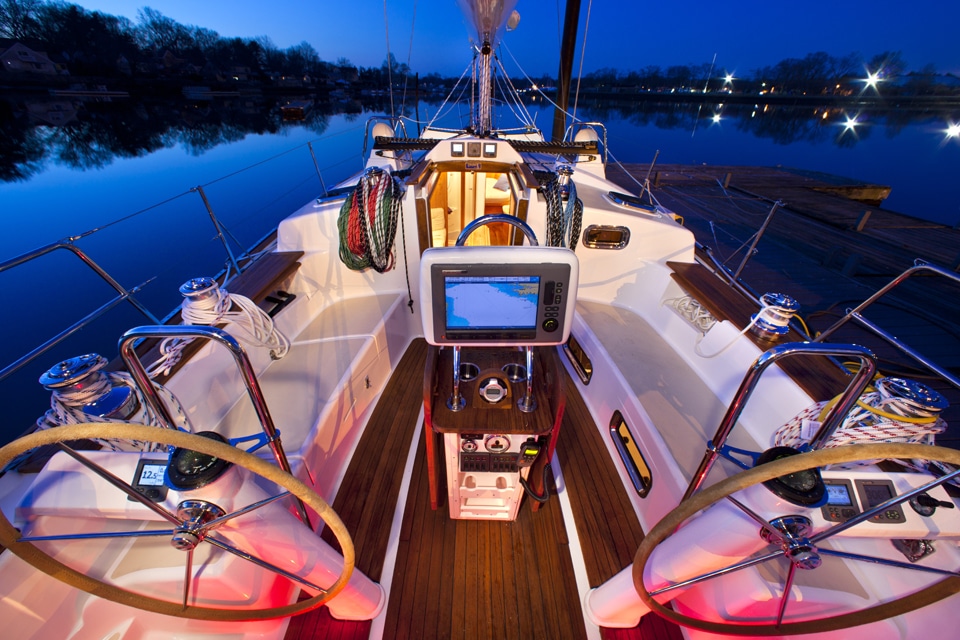
With the two wheels set just forward of a wide seat that folds down to double as a swim and boarding platform, it was easy to find both a comfortable perch and good sightlines to both the horizon and the telltales. The 4000’s motion through the water was smooth and steady, and I found, even below, that I didn’t need the ample handholds included in the design. This sure-footed ride was due, at least in part, to the lead-bulb beavertail keel (a fin or keel/centerboard are other options). The one hitch, as the wind ticked up, was a sticking helm when the carbon rudder and shaft loaded up, indicating that just-launched hull number one needed an adjustment to its wire-and-chain steering gear or a rethink of the rudder bearings. Otherwise, though, the Edson steering provided good feedback to the helmsman.
Under power, the 75-horsepower Volvo turbo with saildrive and four-bladed prop (a 55-horse Volvo is standard) moved us along with authority; thanks to the bow thruster, maneuverability was assured. Jackett said that during sea trials on the previous day, boat speed registered 6.5 knots at 2,000 rpm and topped out at more than 9 knots at 3,200 rpm. I did duck below while we motored to see if the noise level was tolerable. It was.
The 4000’s hull is a foam-cored epoxy-and-glass composite sandwich; the deck is cored with balsa, with solid epoxy and aluminum “windows” for drilling, tapping, and mounting hardware. Interior paneling and joiner work is done in American cherry, giving the saloon and owner’s cabin forward a rich, warm feeling.
The owner of hull number one plans on cruising with children, so in addition to settees that double as sea berths to either side of a centerline drop-leaf table, Jackett replaced cabinets located outboard to starboard with a fold-out pilot berth—a custom touch it’d be hard to obtain from a straight production builder.
The owner’s cabin, behind the chain locker and watertight bulkhead, features tongue-and-groove woodwork, a centerline queen berth, and a head with a separate stall shower.
Aft of the portside galley (whose counters are a granite/foam composite sandwich intended to trim pounds) and opposing nav center, owners have a choice of a two-cabin layout or a single guest cabin to starboard and a quite large storage locker to port that’s accessed from the cockpit. As one would expect on a boat built for cruising, an abundance of storage drawers, bins, and hanging lockers are found throughout, and there’s a galley designed to put a smile on the face of the most demanding cook.
Visit any boat show, and you’re bound to find a line at the Tartan display. Tim Jackett and the designers who preceded him have produced a fleet of boats that have attracted a large and loyal following. The 4000 breaks new ground from a design standpoint, but as far as being a rock-solid sailer and sweet-looking cruiser, well, it’ll fit right in with the rest of the family.
LOA 40′ 8″ (12.4 m.)
LWL 36′ 5″ (11.10 m.)
Beam 13′ 0″ (3.97 m.)
Draft 7′ 0″ (2.13 m.)
Sail Area (100%) 929 sq. ft. (86.3 sq. m.)
Ballast: fin 6,400 lb. (2,903 kg.)
beavertail 8,000 lb. (3,629 kg.)
centerboard 8,600 lb. (3901 kg.)
Displacement: fin 19,604 lb. (8,892 kg.)
beavertail 20,104 lb. (9,119 kg.)
centerboard 21,104 lb. (9,573 kg.)
Ballast/D (f/b/c) .33/.40/.41
D/L (f/b/c) 137/186/195
SA/D (f/b/c) 20.9/20.1/19.5
Water 100 gal. (379 l.)
Fuel 50 gal. (189 l.)
Mast Height 64′ 2″ (19.56 m.)
Engine 55-hp. Volvo, saildrive
Designer Tim Jackett
Price $425,000
Tartan Yachts
(440) 357-7777
www.tartanyachts.com

